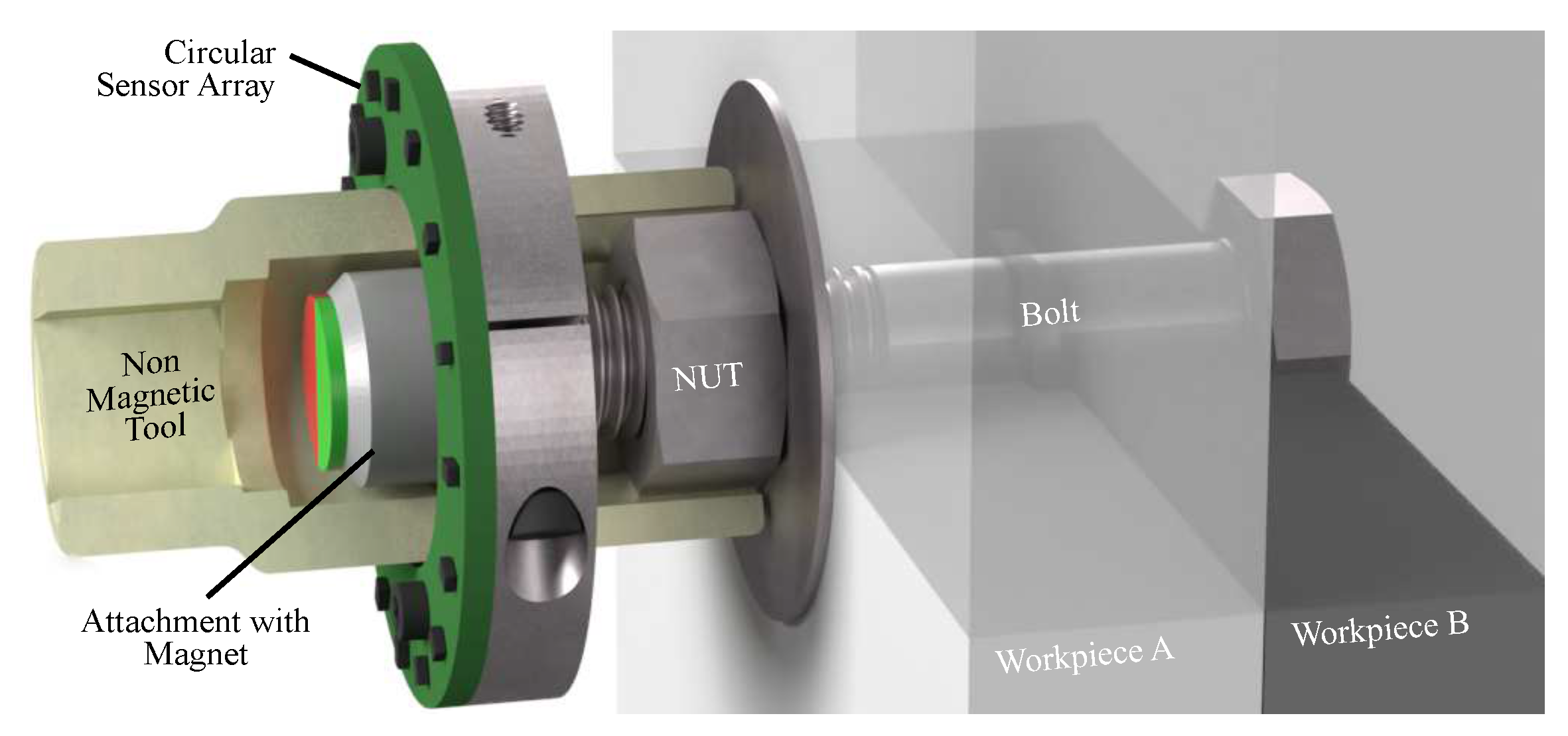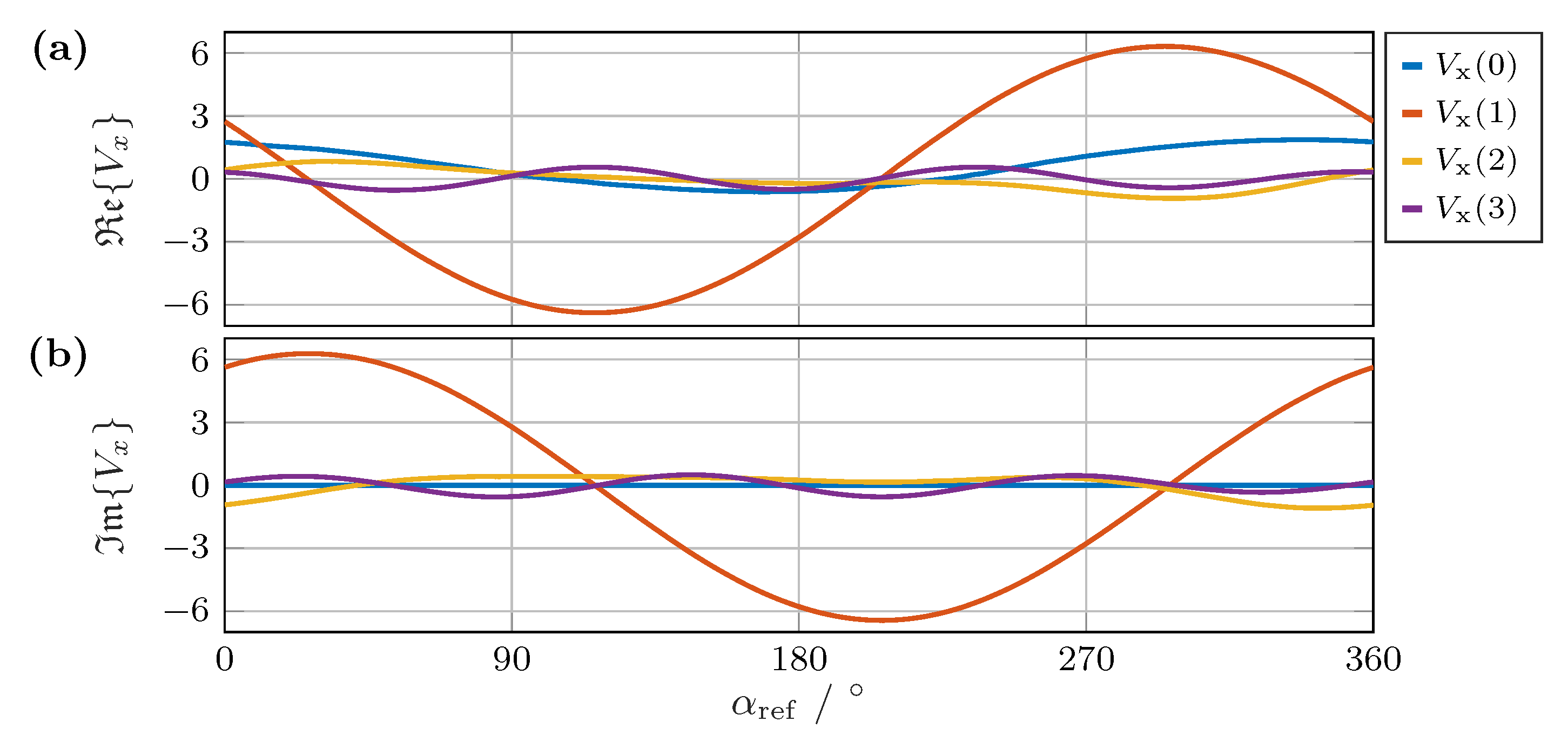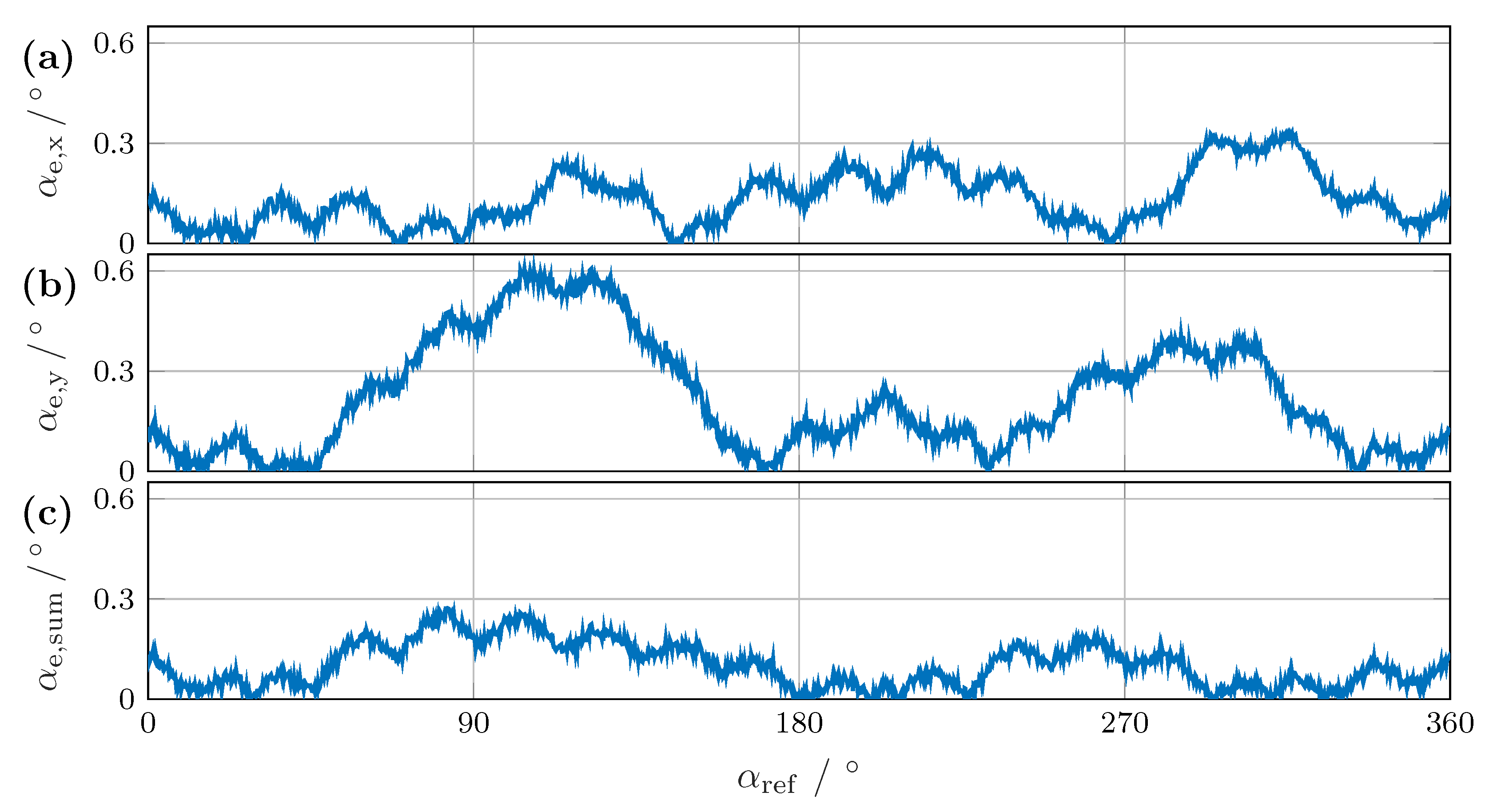Signal Processing Using a Circular Sensor Array to Measure the Torsional Angle of a Bolted Joint
Abstract
:1. Introduction
2. State of the Art
3. Hardware Description
3.1. Sensor and Magnet Arrangement
3.2. Data Acquisition
4. Signal Processing
4.1. Direct Method
4.2. Training Method
5. Experiments
5.1. Test Bench for Verification
5.2. Output Signals
5.3. Measurement Results
5.4. Future Tool Design
6. Application Perspectives
7. Conclusions
Author Contributions
Funding
Institutional Review Board Statement
Informed Consent Statement
Data Availability Statement
Acknowledgments
Conflicts of Interest
References
- SCS Concept. Freedom 3 Torque/Angle DigitalWrench, 30 Nm. Datasheet. 2018. Available online: https://www.scsconcept.com/brochure/en/Freedom3.pdf (accessed on 23 March 2022).
- Meyer-Eschenbach, A.; Grätsch, T.; Höring, G.; Rajabi, D.; Knoth, J.-H.; Fischer, M.; Stahl, M.; Büchle, J.; Dieterle, H.; Brahm, F.; et al. Schraubenverbindungen; Vogel Communications Group: Würzburg, Germany, 2022; ISBN 978-3-8343-3464-0. [Google Scholar]
- Schüthe, T.; Riemschneider, K.-R.; Meyer-Eschenbach, A. Magnetic sensor array for determining the assembly torsion and preload of a bolted joint. In Proceedings of the 2022 IEEE Sensors Applications Symposium (SAS), Sundsvall, Sweden, 1–3 August 2022. [Google Scholar]
- NXP Semiconductors. KMZ60 Angle Sensor with Integrated Amplifier. Datasheet. 2014. Available online: https://www.nxp.com/docs/en/data-sheet/KMZ60.pdf (accessed on 30 November 2021).
- TDK Electronics. TAS2143-AAAA. Datasheet. 2019. Available online: https://product.tdk.com/system/files/dam/doc/product/sensor/angle/tmr-angle/data_sheet/ds_sensor_tmr-angle_tas2143-aaaa_en.pdf (accessed on 22 November 2022).
- Infineon. TLE5501 Angle Sensor. Datasheet. 2019. Available online: https://www.infineon.com/cms/en/product/sensor/magnetic-sensors/magnetic-position-sensors/angle-sensors/tle5501-e0001/ (accessed on 9 December 2020).
- Schüthe, T.; Meyer-Eschenbach, A.; Riemschneider, K.-R.; Weithoff, F.; Richter, S.; Brodersen, J. Werkzeug für die Schraubenmontage mit Magnetsensor-Array zur Torsionsmessung. Patent Application DE102022002785A1, 28 July 2022. [Google Scholar]
- Hongde, C.; Hongwu, Z.; Rongxiang, Z.; Wen, F. Intelligent Fastener Capable of Sensing Looseness of Fastener Nut and Online Monitoring System. Patent Application CN110273909A, 24 September 2019. [Google Scholar]
- Infineon. TLE5xxx(D) Calibration 360°. Datasheet. 2019. Available online: https://www.infineon.com/dgdl/Infineon-TLE5xxx(D)_Calibration_360_AN-v02_00-AN-v02_00-EN.pdf:PDF?fileId=5546d46264a8de7e0164f09d8bfa228d (accessed on 26 November 2021).
- Sirohiwala, A.; Bussing, W.; Allegro MicroSystems Inc. Advanced On-Chip Linearization in the A1332 Angle Sensor IC. Datasheet. 2015. Available online: https://www.allegromicro.com/en/insights-and-innovations/technical-documents/hall-effect-sensoric-publications/advanced-on-chip-linearization-a1335-angle-sensor-ic (accessed on 19 January 2022).
- Jerance, N.; Arlot, R. Positionssensor mit Veränderlicher Magnetisierungsrichtung und Produktionsverfahren. Patent EP1989505B1, 21 July 2010. [Google Scholar]
- Schweizer, P.; Kenney, C.; Andrews, R. Off-Axis Magnetic Angular Sensor Using a Magnetic Sensing Probe and Multipole Magnet. Array. Patent Application US020200408856A1, 31 December 2020. [Google Scholar]
- Grönefeld, M.; Gerhartz, J.; Ohmer, M. Verfahren zur Erfassung Linearer Relativbewegungen Zwischen Dauermagneten und. Sensoren. Patent EP0979988B1, 25 June 2003. [Google Scholar]
- Bakos, Á.; Gozse, I.; Soumelidis, A. Design and analysis of a magnetic off-axis rotary position sensing device. In Proceedings of the 22nd Mediterranean Conference on Control and Automation, Palermo, Italy, 16–19 June 2014. [Google Scholar]
- Grim, V.; Ripka, P.; Fischer, J. Characterization of circular array current transducers. In Proceedings of the IEEE Sensors Applications Symposium (SAS), Sophia Antipolis, France, 11–13 March 2019. [Google Scholar]
- Yu, H.; Qian, Z.; Liu, H.; Qu, J. Circular array of magnetic sensors for current measurement: Analysis for error caused by position of conductor. Sensors 2018, 18, 578. [Google Scholar] [CrossRef] [PubMed]
- Guo, C.; Chen, L.; Zhang, H. Current measurement for curved conductor based on 3-d coreless TMR sensor array. J. Phys. Conf. Ser. 2021, 1887, 012025. [Google Scholar] [CrossRef]
- Süss, D.; Brückl, H.; Prügel, K.; Satz, A.; Raberg, W. Magnetsensorbauelement und Magneterfassungsverfahren. Patent Application DE102016112008A1, 30 July 2016. [Google Scholar]
- Zimmer, J.; Satz, A.; Raberg, W.; Brückl, H.; Süss, D. Device, Magnetic Sensor Device and Method. Patent Application US020150185297A1, 2 July 2015. [Google Scholar]
- Paul, J.; Schnieders, C.; Traute, J.; Lehndorff, R.; Conca, A.; Leven, B.; Hillebrands, B.; Casper, F.; Jakob, G.; Kläui, M. B3.2—Sensors Based on Tunnel Magnetoresistance—New Technology, New Opportunities. In Proceedings of the SENSOR, AMA Service, Nürnberg, Germany, 19–21 May 2015. [Google Scholar]
- Jin, Z.; Mohd Noor Sam, M.A.I.; Ando, Y. Serial MTJ-based TMR sensors in bridge configuration for detection of fractured steel bar in magnetic flux leakage testing. Sensors 2021, 21, 668. [Google Scholar] [CrossRef] [PubMed]
- Schüthe, T.; Albounyan, A.; Riemschneider, K. Two-Dimensional Characterization and Simplified Simulation Procedure for TMR Angle Sensors. In Proceedings of the 2019 IEEE Sensors Applications Symposium (SAS), Sophia Antipolis, France, 11–13 March 2019. [Google Scholar]
- Wurft, T.; Raberg, W.; Prügl, K.; Satz, A.; Reiss, G.; Brückl, H. Evolution of magnetic vortex formation in micron-sized disks. Appl. Phys. Lett. 2019, 115, 13. [Google Scholar] [CrossRef]
- Wurft, T. Investigation of the Magnetic Vortex State for Spin-Valve Sensors. Ph.D. Thesis, Universität Bielefeld, Bielefeld, Germany, 2018. [Google Scholar]
- Suess, D.; Bachleitner-Hofmann, A.; Satz, A.; Weitensfelder, H.; Vogler, C.; Bruckner, F.; Abert, C.; Prügl, K.; Zimmer, J.; Huber, C.; et al. Topologically Protected Vortex Structures to Realize Low-Noise Magnetic Sensors. arXiv 2017, arXiv:1712.07061. [Google Scholar]
- Lehner, G.; Kurz, S. Elektromagnetische Feldtheorie; Springer: Cham, Switzerland, 2021. [Google Scholar]
- Nexperia, B.V. 74HCT4066 Quad Single-Pole Single-Throw Analog Switch. Datasheet. 2021. Available online: https://assets.nexperia.com/documents/data-sheet/74HC_HCT4066.pdf (accessed on 15 June 2023).
- Nexperia, B.V. 74HCT4067 16-Channel Analog Multiplexer/Demultiplexer. Datasheet. 2021. Available online: https://assets.nexperia.com/documents/data-sheet/74HC_HCT4067.pdf (accessed on 15 June 2023).
- Analog Devices, Inc. AD7380-4 Differential Input, Quad, External Reference Simultaneous Sampling, 16-Bit, SAR ADC. Datasheet. 2022. Available online: https://www.analog.com/media/en/technical-documentation/data-sheets/ad7380-4.pdf (accessed on 18 December 2022).
- Texas Instruments Inc. TM4C1294NCPDT 32-Bit-ARM-Cortex-M4F-Based MCU. Datasheet. 2014. Available online: https://www.ti.com/product/de-de/TM4C1294NCPDT (accessed on 16 December 2022).
- Schüthe, T.; Jünemann, K.; Riemschneider, K.-R. Tolerance Compensation based on Gaussian Processes for Angle Measurements with Magnetic Sensor Arrays. In Proceedings of the IEEE Sensors 2020, Rotterdam, The Netherlands, 25–28 October 2020. [Google Scholar]
- Rasmussen, C.E.; Williams, C.K.I. Gaussian Processes for Machine Learning; Massachusetts Institute of Technology: Cambridge, MA, USA, 2006; Available online: http://gaussianprocess.org/gpml/ (accessed on 27 October 2021).
- CUI-Devices. AMT212D-V Modular Absolute Encoder (14 Bit). Datasheet. 2021. Available online: https://www.cuidevices.com/product/motion/rotary-encoders/absolute/modular/amt212d-v (accessed on 23 November 2022).
- Dr. Johannes Heidenhain GmbH. Angle Encoders Product Page. Datasheet. 2023. Available online: https://www.heidenhain.com/products/angle-encoders (accessed on 15 June 2023).
- Anton Paar GmbH. Rheometer—The MCR Rheometer Series. Datasheet. 2023. Available online: https://www.anton-paar.com/uk-en/products/group/rheometer/ (accessed on 15 June 2023).
- Ahmed, M.; Noor, S.M.; Hassan, M.K.; Soh, A.C. A review of strategies for parabolic antenna control. Aust. J. Basic Appl. Sci. 2014, 8, 135–148. [Google Scholar]










| 3 | 4 | 5 | 6 | 7 | 8 | 9 | 10 | 11 | 12 | |
|---|---|---|---|---|---|---|---|---|---|---|
| l | 8.200 | 6.106 | 4.425 | 3.447 | 2.796 | 2.367 | 2.049 | 1.813 | 1.623 | 1.473 |
| 2.342 | 0.827 | 0.288 | 0.142 | 0.136 | 0.129 | 0.115 | 0.113 | 0.106 | 0.110 | |
| 1.319 | 0.392 | 0.098 | 0.040 | 0.038 | 0.046 | 0.034 | 0.032 | 0.029 | 0.033 | |
| 0.647 | 0.208 | 0.072 | 0.033 | 0.029 | 0.031 | 0.025 | 0.025 | 0.021 | 0.025 |
Disclaimer/Publisher’s Note: The statements, opinions and data contained in all publications are solely those of the individual author(s) and contributor(s) and not of MDPI and/or the editor(s). MDPI and/or the editor(s) disclaim responsibility for any injury to people or property resulting from any ideas, methods, instructions or products referred to in the content. |
© 2024 by the authors. Licensee MDPI, Basel, Switzerland. This article is an open access article distributed under the terms and conditions of the Creative Commons Attribution (CC BY) license (https://creativecommons.org/licenses/by/4.0/).
Share and Cite
Schüthe, T.; Riemschneider, K.-R.; Meyer-Eschenbach, A. Signal Processing Using a Circular Sensor Array to Measure the Torsional Angle of a Bolted Joint. Sensors 2024, 24, 2719. https://doi.org/10.3390/s24092719
Schüthe T, Riemschneider K-R, Meyer-Eschenbach A. Signal Processing Using a Circular Sensor Array to Measure the Torsional Angle of a Bolted Joint. Sensors. 2024; 24(9):2719. https://doi.org/10.3390/s24092719
Chicago/Turabian StyleSchüthe, Thorben, Karl-Ragmar Riemschneider, and Andreas Meyer-Eschenbach. 2024. "Signal Processing Using a Circular Sensor Array to Measure the Torsional Angle of a Bolted Joint" Sensors 24, no. 9: 2719. https://doi.org/10.3390/s24092719
APA StyleSchüthe, T., Riemschneider, K.-R., & Meyer-Eschenbach, A. (2024). Signal Processing Using a Circular Sensor Array to Measure the Torsional Angle of a Bolted Joint. Sensors, 24(9), 2719. https://doi.org/10.3390/s24092719





